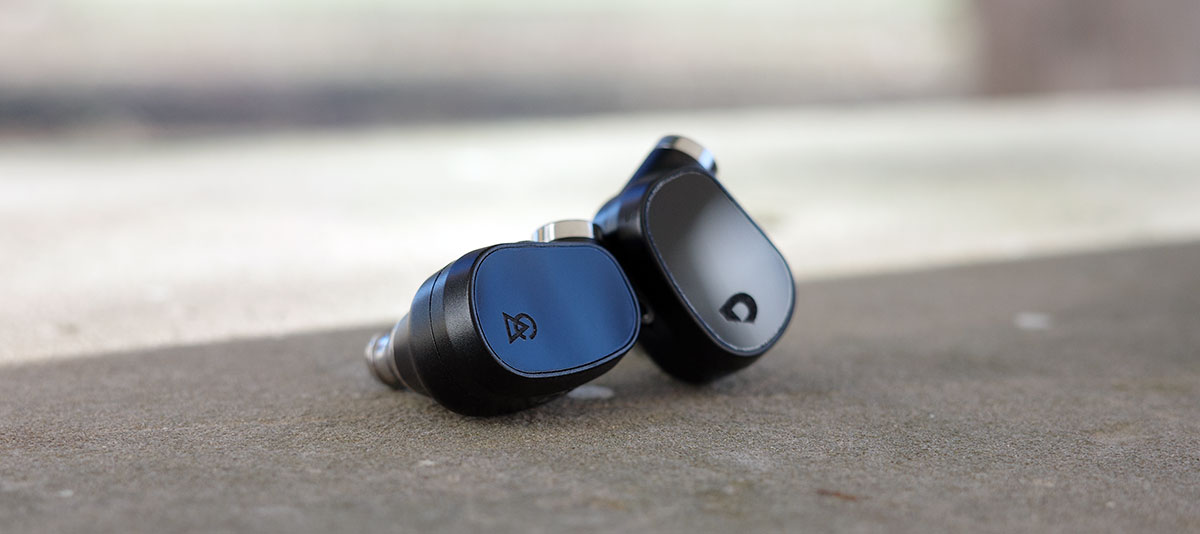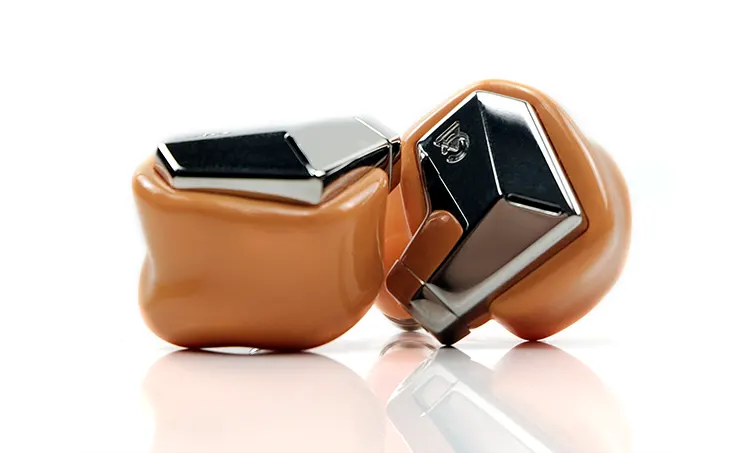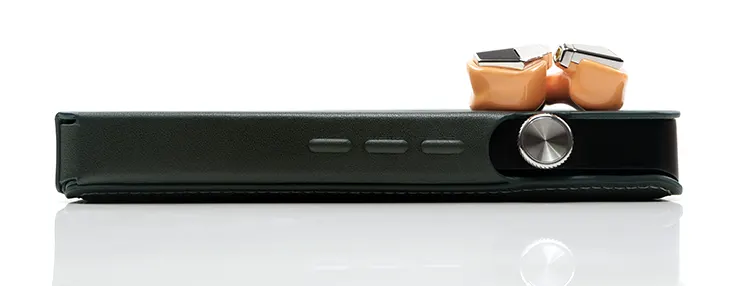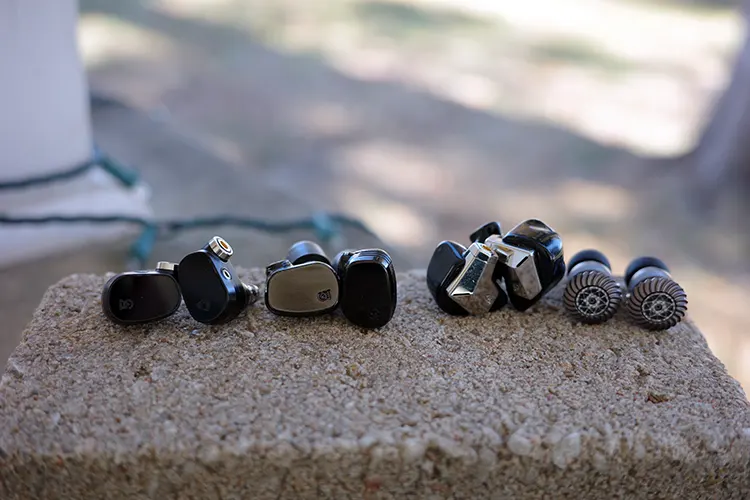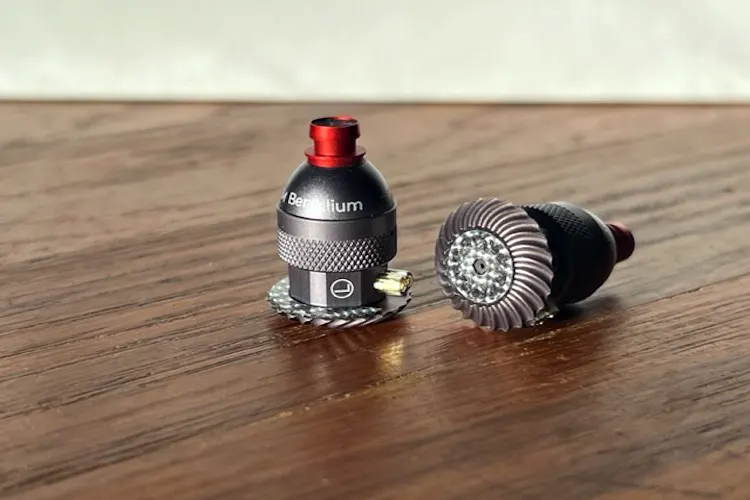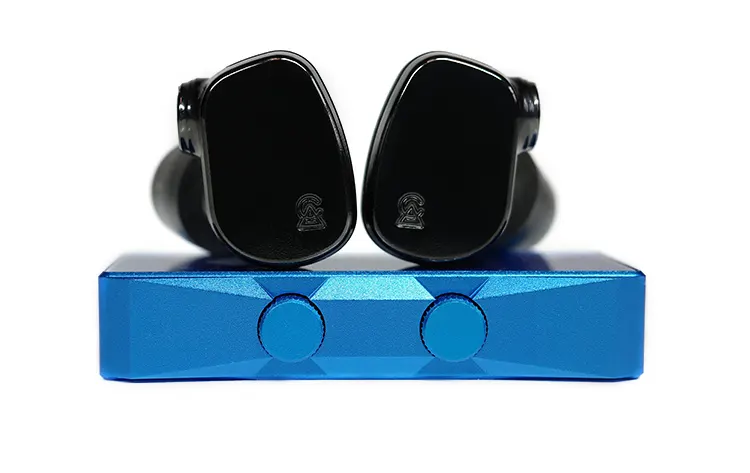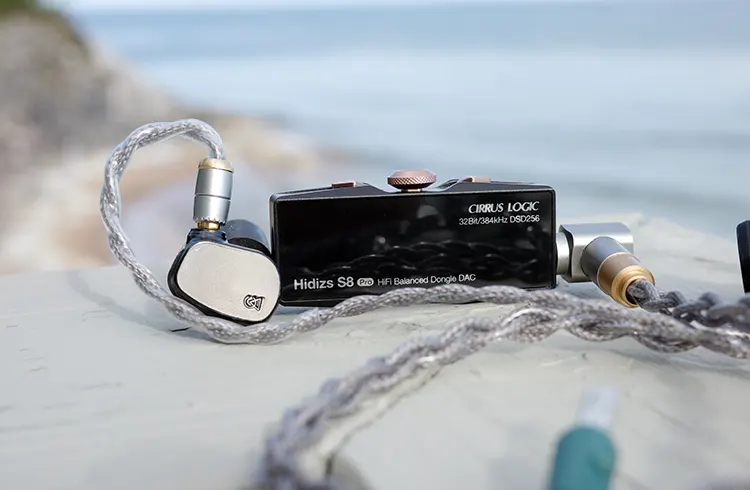Select Comparisons
Campfire Audio Supermoon
Features
The Supermoon contains a 14.2mm planar magnetic driver. It also has a backplate with 3D-printed acrylic shells, for a completely different design, especially since mine is the custom version.
The nozzle depth reaches further as one would expect, since it is a custom, too. The Supermoon’s impedance is 15.5Ω @ 1kHz compared to the Astrolith’s 8.2Ω @ 1kHz.
Design
The Supermoon’s custom acrylic shells were created from my impressions with excellent quality. As a result, they are quite large but with excellent fit. It does take a bit to put them in, what with the turns and bends of course
In contrast, the Dark Star’s stainless shells have a much simpler profile design in line with more traditional earphones but are tip-dependent for fit. I found the fit to be very good, with a small amount of play, which did not hinder once the music started.
I like both designs, applauding CFA for making the Dark Star in a smaller size, even with the large Mushroom tips, resulting in a cohesive design and fit.
Of the two, the Supermoon will draw more attention, especially since it is a custom. For the regular Supermoon, this holds even more, what with the stainless backplate and different colors available.
Both provide stability in-ear, but this isn’t a fair comparison. Isolation from the Supermoon is almost on par with the Dark Star, regardless of tip choice on the DROP x CFA model.
While they are both vented designs, the Supermoon does a better job of filling every inch of the inner and outer ear, passively blocking noise in the same environmental situations, but less than the Dark Star. The seal is not airtight on the Supermoon in other words.
Bass Performance
The large planar of the Supermoon tries mightily but cannot compete in sheer weight against the lows of the Dark Star. But what it lacks in quantity, it certainly makes up for in quality. Superb is a word that comes to mind. Just right is another. Coherence and completeness are two more.
Where the Dark Star lets the listener know there is a low-end, the Supermoon affords the listener the complete picture. Mind you, this isn’t neutral, but more akin to a speedy presentation, with a very fast response similar to a percussion member striking a tympani with rapid thrusts.
Both afford their presentations to be amenable but from different directions. The volume and girth of the Dark Star are more like the Vega versus the value, quality, and completeness of the Supermoon.
Midrange Performance
Where the Dark Star provides a slightly withdrawn midrange and excellent holography, the Supermoon is more neutral in response.
Where vocals come across with more sibilance (but accuracy) in the Dark Star, the Supermoon presents the vocals more neutrally, without promoting a distinctness to them.
I actually prefer the Dark Star’s version of the midrange, and this could come down to the Sonion BA being allowed to operate on its own versus the singular planar driver of the Supermoon.
The lack of sibilance is appreciated, even if the Dark Star presents those “S” sounds realistically and the way the song is meant.
There is a warmth to the vocals across the board in the Supermoon, that is missing from the Dark Star. Instead, you get the realism and holography.
Treble Performance
The two Knowles BAs provide excellent reach up top, with that sparkle mentioned, whereas the Supermoon presents a more even structure to the top end.
The rounding effect of the Supermoon is heard more readily in percussive strikes. Where the Dark Star provides a vibrancy to the strikes, the Supermoon presents the whole rather than the part.
The Dark Star provides a quicker response, and an ever so slight thinning quality, with excellent definition to the treble range. The Supermoon provides excellent weight to the treble range but with less definition.
The speed of the Dark Star comes across better, too. That slight thinning actually helps promote a more succinct, tighter structure; which is better defined than the less-controlled more smoothly treated Supermoon.
Where the Dark Star does the Samba, the Supermoon does the Waltz.
Staging Performance
The Dark Star is cavernous. The Supermoon is more intimate but with very good spatial awareness. Imaging, especially off-center is excellent in both, but here again, the multi-driver Dark Star can help its case by having a specialized driver.
The smooth layering of the Supermoon provides a cohesive across-the-board approach to the music that simply carries forth without issue.
The Dark Star promotes more distinct layers and separation, affording each to promote its best characteristics. In that vein though, the midrange does tend to come across as more distinct in the Dark Star, which going back-to-back may be a bit off-putting.
Spirit Torino Twin Pulse Beryllium IEM
Driver Configuration
The IEM Twin Pulse uses the same inertial frame technology found in two of the company’s headphones, the Twin Pulse and Twin Pulse Pro.
The Twin Pulse Motor Assembly employs two identical crossover-free 10mm micro dynamic drivers with neodymium magnets and Beryllium-treated membranes acting synchronously to zero out typical micro-acoustic problems and phase interference.
The treated membranes ensure that both drivers work together, with a fast response time to the sound signal.
To allow this tech to function correctly at a fraction of the size, Spirit Torino introduced a bullet-type design along with custom venting ducts and some clever internal acoustical chamber engineering to keep distortion to a minimum.
Some of that engineering also includes anti-resonant treatment of the inertial frame which takes the form of a series of stunning-looking Texalium composite inserts.
Filters
Changeable filters, (red, black, and gray), help to fine-tune the sound as well. Gray for a linear studio response, red for a response with +3dB in the low range, and black for a response with -3dB in the low range.
While not as much as some changeable filtered IEMs, the differing filters did promote their signature onto the overall sound.
Design
The Twin Pulse is a three-major pieced IEM, with the main shell, sound extractor (bulbous semi-cone), and filter.
Shaped like a long, artistic cylinder, the faceplate is adorned with the Texalium inserts as well as the Spirit Torino recognizable shiny, multi-starred insert. Surrounding the star is a gray/bronze cog-like wheel, giving the IEM a distinct and quite exquisite look.
The IEM comes standard with two cables a 3.5mm SE and 4.4mm balanced cable as well as a 6.35mm single-end adapter.
Bass Performance
The Spirit Torino is one of the more balanced signatures I have heard of late, without pushing too deep down low; in contrast to the rumbling heard from the Dark Star.
Where the Spirit Torino provides an evenness to the sound, the Dark Star lets the listener know there is bass to be heard down low.
Sub-bass holds down the signature, without being too authoritative or overpowering, but still prominent. Many times, when using dynamic drivers in an IEM, a compromise must be made either down low or up top (most likely).
However, the Twin Pulse driver system seems to have countered that with a good natural note and mid-sound, which does not get overshadowed. Balanced.
Not quite as accurate a signature as the UE Live, but with a more natural sound to it. There is a good body to the notes, and the Twin Pulse competes well, especially when we consider the price.
The evenness of sound makes for an easier listen than something like the Campfire Audio Supermoon, which has a sharper upper midsection.
You will get a better treble with the included silicon tips, but the foam provides an excellent seal with better isolation. I used the foam tips for the majority of my testing.
A balanced, smooth sound comes to mind with the gray filter. This sets the tone for an open-airy sound that also comes across as natural and neutral without becoming thin. There is good detail in the signature as well.
Midrange Performance
The Spirit Torino has a more subdued midrange than the Dark Star, but that does not dissuade from its very good purpose. That smooth character ties to both the bass and treble notes in a connective manner that comes across as smooth with more connectivity than the Dark Star.
Where the Dark Star promotes each section as part of the whole, the Spirit Torino takes the whole into account as one. That smooth character may not be for everyone, and when singled out, the Dark Star presents a more coherent midrange.
The Dark Star presents the midrange as a singularity within the signature, where the velvety smoothness of the Spirit Torino acts in concert with the whole signature.
That smoother character of the Spirit Torino works especially well with flowing genres such as soft hip-hop or pop that carry on without too many nuances.
The Dark Star presents a more resolute signature, that allows the individual parts of some genres such as jazz to portray themselves as the center.
Both are very good at what they do. The Dark Star is seemingly the more versatile but could be polarizing as a result since it may not function with as much alacrity as the Spirit Torino.

Treble Performance
The rolled-off top-end of the Spirit Torino is thankfully smooth as well but allows enough detail to be present that you might not miss that extra presence up top. There is no mistaking the top end of the Dark Star and its presence.
Where the Spirit Torino goes for a pleasantly pushed reach that has a smooth, yet detailed signature in the nether regions, the Dark Star affords those same notes to carry their weight and isolation as a “solo” so to speak. Not separate, but distinct enough so that you can enjoy what is present up top.
Where the Spirit Torino again shows a “works well and plays well together” attitude, the Dark Star allows the singularity of each region to speak for itself while being part of the show.
I again appreciate the smooth character of the Spirit Torino with its somewhat punctuation top in a non-committal manner, while the Dark Star lets things flow for their own accord as part of the overall signature.
Staging Performance
Both IEMs carry excellent cubic experiences. But where the Dark Star is more linear in its cubic effect (and expansive), the height lifts the Spirit Torino in a manner not unlike a slightly narrow cathedral with high vaulted ceilings.
In each vein, there is a distinctness of character to what is presented. Even though the Spirit Torino may come across as slightly narrower, that expansive height affords each layer to show itself with character. The melding of those layers comes across better to me as well.
That distinctive nature of the Dark Star may be its fault here when compared to the Spirit Torino. The Torino melds all together in a coherent manner, whereas the Dark Star allows each layer to highlight itself in a slightly less comprehensive showing.
Two different approaches where both are not bad, but distinctly different. The Dark Star highlights where the Spirit Torino melds.
Campfire Audio Solaris 2020
Features
The Solaris 2020 comes in a black PVD finished body carrying dual custom balanced armatures for the highs using CFA’s T.A.E.C. technology, along with a single custom BA for the mids (TAEC), and a then new 10mm dynamic driver for the lows and lower mids.
The diaphragm on the dynamic driver used Chemical Vapor Deposition(CVD) in an amorphous diamond-like carbon (ADLC) structure.
The shell also has those distinctive “chambers” much like many of today, but of note, this was one of the first at the time (among many) to use chamber design for sound tuning.
With the typical-for-CFA MMCX connection, you are assured a quality operation.
Design
The 2020 iterations of the Solaris carry a “⅔’s” design to the shell, which fits better into your ear. The company took note of the larger size (and consumer comments) to design and implement a smaller shell structure with good results.
The familiar thick teardrop shape has a flat faceplate laden with the CA logo and a single vent hole on the top allowing the unit to breathe. There is also a small Allen key next to the hole used to tie the faceplate and inner shell together.
The chrome nozzle comes across as slightly smaller with dual lips for tip mounting. An ornate protective grill covers the nozzle lending for an overall upscale look to the Solaris.
Patterned “grooves” give the user a good grip while looking like a part of an upscale IEM.
Bass Performance
There is no denying the familial resemblance down low of both and this could be the closest tuning to the Dark Star (outside of the Black Star). The bass is taut and controlled on the Solaris in a better manner than the deeper-reaching Dark Star.
Where the Dark Star is allowed to show off the low-end (much like the OG Vega), the Solaris is tight and controlled while reaching satisfactory low levels.
The bass of the Solaris is one of the reasons I like it so much. Deep reaching but controlled, with little bleed into the mids, converse to the Dark Stars emphasis down low with little care (in a good manner) to the overall.
Where the Solaris dances in an ‘elegant manner’ down low, the Dark Star does the ‘Jitterbug’.
Midrange Performance
The midrange of the Solaris may well be its weak point, but only because it is so far forward (to me). Detailed and succinct in quality, the midrange of the Solaris is the star of the show.
Where the bass comes across as controlled, setting the tone; the midrange shows its character in vibrant vocals and midrange instruments such as guitar solos.
There is a pulsating effect to the single balanced armature that may come across as antithesis to the lows until you understand how good the quality is.
Where the Dark Star is a bit reserved in the midrange, the Solaris has a punctuating vibrant character allowing the mids to carry forth the show.
Some will find the Solaris too far forward in the midrange and may appreciate the tuning of the Dark Star specifically for its merits. But the sumptuous qualities of the Solaris midrange make it a superbly confident IEM in this range.
Treble Performance
The custom dual BAs certainly present themselves as part of the signature. With a stretched (but very accurate) top end, there is little to complain about in the Solaris reach and quality.
Some may find that it has too much sparkle, but I found this to be true only under certain situations, and it never became sibilant in its performance.
Sometimes BAs carry sibilance as part of their signature (which can certainly be construed as the recording, too) but the Solaris shows its mettle by extending enough to spread the soundstage out while giving the notes excellent weight.
Where the Dark Star comes across as very sparkly (and sometimes sibilant), the Solaris goes right to the edge of that representation but does so without becoming too grating or thin in note quality.
Again, where the Dark Star affords each part to show off in singularity, the Solaris presents a more coherent signature, but with excellent weight to the notes.
Staging Performance
Following the Supermoon, the height of the Solaris offers the most character, but the depth with which the notes comes across gives excellent fore/aft quality as well. The width does carry beyond the users head for a 3D effect, but not in a cubic manner such as the Dark Star.
Set in a similar manner to the Supermoon, but with better weight filled into the “meat” section of the soundstage, the Solaris comes across with excellent weight characteristics to the notes that do not dissuade from the excellent detailed resolution.
The Dark Star has an exceptionally cubic effect allowing each layer and instrument its own space, where the Solaris melds the whole together more like the Spirit Torino, but with more distinction.
The way the Solaris puts the whole signature together makes for an extraordinary listen, where the Dark Star makes you focus on the individuality a bit more.
My Verdict
The companionship between DROP and Campfire Audio brings the best of both into play in the Dark Star. This multi-driver IEM comes with very good, but distinct, tuning.
There is no denying its heritage towards the Vega (in my opinion) when discussing the low-end, and that is a positive aspect. If you like the Vega, you will like the Dark Star.
The midrange while set back do not shy away from the presentation, with excellent vocal treatment affording the singers to showcase their wares. That quality may also be a flaw as well.
The sparkle in the upper mids, that reaches into the treble region can deliver some very good reach but become too sparkly to some (somewhat antithesis to the slightly withdrawn mids).
Add in that if there is any sibilance in the recording, it does come through as well and the tuning could be construed as overly bright without proper control.
I would counter that with that reach affords the top end to stretch much the way the excellent low end does, giving room for those wonderfully-set mids to come across with a distinctive character and excellent weight.
The soundstage is one of the most cubic I have heard, but that spatial awareness allows each part a distinct place within the tuning, with excellent results, helping balance the signature somewhat.
The Dark Star is its own beast with a tuning that can be vibrant in character but lacks the micro details some appreciate. However, there is no denying that in forging its own path that may be its greatest strength.
Campfire Audio x DROP Dark Star Technical Specifications
- Drivers: (1) 10 mm dual-magnet dynamic driver with bio-film membrane, (1) Sonion midrange balanced armature, (2) Knowles tweeter balanced armatures
- Impedance: 9.212 ohms
- Frequency response: 5 Hz – 20 kHz
- THD <1%
- SPL: 94 dB (at 1 kHz, 7.74 mVrms)




